The row from Valentino Pier Park in Red Hook to Pier 101 on Governor’s Island for City of Water Day on July 18 presented the first real sea challenge to our beloved dories. It was at once our first test in coordinating a flotilla of dories and in navigating tricky harbor currents. Full disclosure: after surviving two crossings, we feel that our dories are best and happiest on the tranquil and familiarly toxic waters of the Gowanus Canal. We can’t stress this enough: know your water’s currents and tides, and bring safety gear. Enough pfd’s, plenty of line, a spare oar and a civilian band radio are not at all bad things to have along — take it from us, we were underequipped, and we were lucky. That said, our dories did take waves well, and performed in plywood homage to their illustrious forebears – the fishing dories of Greenland’s Grand Banks. We all survived the crossing uninjured save for really gnarly blisters on our hands and chafe marks on our forearms from our cheap plastic life preservers.
We set out at 8 am from the Gowanus Studio Space, lowering the workshoppers’ boat and our improved battleship grey semi-dory down the stairwell using our historic block and tackle, then loaded the boats into a rented truck with the three other water-ready dories. At Valentino Pier Park on Coffey Street, we set to putting finishing touches on the Princess Ladyboat and the as-yet-unnamed Workshopper’s dory (I’ll call her Henrietta for the sake of brevity), adding oar locks and rationing out our life jackets, bailing buckets, makeshift cleats and tender lines. By 9 am our five boats were fully crewed with 14 passengers and 5 captains — we had 5 people in Josephine, 4 in the Mudflap Mermaid, 5 in Henrietta, 4 in Princess Ladyboat and 3 in the semi-dory, a.k.a. HMS Biggie Smalls. We conferred with the Red Hook Boaters, our hosts at Valentino, on the preferred route. The plan was to follow the Brooklyn coast a mile up the Buttermilk Channel, stop and regroup between the two hulking cranes of American Stevedoring, and then cut across the channel – a quarter mile at its narrowest point.
Low tide was estimated about 11 am, and so we were expecting some opposing tidal current as well as some natural current from the Buttermilk. At just after 10 am, the Red Hook Boaters launched their flotilla of about two dozen kayaks, followed by the Sebago Kayak Club. They were joined by a couple of Gowanus Dredgers in a canoe, and several assorted independent kayakers. Once the beach was cleared, we coffin-carried our boats down to the water and launched. Before we had left Valentino Cove, the captain of the Henrietta reported oarlock failure. The wood we had chosen to brace the steel oarlocks was too soft, and with just a couple of pulls of the oars the locks had come free. As we hadn’t bothered to drill and pin the oars to the oarlocks, this meant that the oarlocks would easily come free. A rush effort to correct this error was underway. Now, the pilot of the safety boat (a fishing skiff with an outboard engine) which had been patiently awaiting our departure from the cove grew impatient with us, shouting and waving his arms and prompting us to get on with our launch. We should have kept him waiting while we tested the boat and made sure its oarlocks would hold.
Instead, we set out. The fastest of our ships, the Princess Ladyboat, piloted by Captain Angela, slid around the edge of the rocky point beneath the Snapple soft drink distribution warehouse, and disappeared into the Channel. The Mudflap Mermaidboat was next, and it too deftly skirted the exposed mossy rocks and made it into the Buttermilk. Josephine was third, and made it around the corner with little difficulty. Next came the HMS Biggie Smalls, followed by the hastily repaired and still struggling Henrietta. Biggie Smalls’ oarlocks had also been fastened into soft wood, and the two boats struggled to fight the current. With their oars coming undone at every stroke and the unrelenting current pushing ever away from our destination, the two boats were dragged out into the wide center of the channel. As the three swift lead dories made their way up alongside the Snapple distribution warehouse, poor Henrietta and the HMS Biggie Smalls foundered in the current, the safety skiff circling them like an impatient shark. “Need a tow? Need a tow?” We could hear the safety boat’s pilot shouting as we fought to gain on the Channel’s pull.
Even for the lead boats, the current was a fierce opponent. At best their captains were rowing at maybe 2 knots against the tide, gaining on the shore at a pace slightly slower than your typical grand-dad’s morning walk to the corner store. Still the lead dories fought on, even as our dear friends in the Henrietta chose to take the safety boat’s tender line and accept a tow back to the cove. This was a wise decision, and though our spirits suffered briefly for the loss of our friends, we were glad they would soon be safe and out of the danger of the bustling harbor. [A lesson learned here: always have a hook or cleat which a rescue boat can attach to, or else an attached line long and strong enough to facilitate a rescue, just in case. Henrietta’s crew had to hand hold the safety boat, and being towed in a dory behind an outboard motor’s wake is not an experience we would recommend to anyone. Thanks again go out to Ray Fusco and the MWA/City of Water Day coordinators for having skilled captains and quick ships on hand for our safety.]
With bravado, courage and no small amount of obstinacy, HMS Biggie Smalls finally managed to right its course, and through the hard rowing of Captain Stephan, it made its way at a sea slug’s pace up the Channel. The three lead boats had by now reached the Stevedoring cranes and were fighting their way across the Buttermilk towards the island. Before crossing, we discussed whether to continue on or go back with the aborted boat, but decided we were closer to the goal now than to the entry point, and we had little choice but to continue. Ben, Stephan and Dylan were scheduled for a 12:30 pm artist talk at the Cuny Institute for Sustainable Cities exhibition in Pershing Hall and it was now nearing noon. We paused anyway to pass a stowed-away box of donuts between the dories. Sugar-enriched, we made our way into the Channel, dodging the checkered water taxis and absent minded pleasure yachts and fighting against their wakes. A water-cannon display from the FDNY fireboat marked our crossing. The mile and a quarter row had taken us nearly two hours.
On land, we debriefed on our blundering voyage with MWA safety organizers, and shared stories with other rowers. The Buttermilk Channel (word has it) is a notoriously ill-mannered waterway. With cold brackish water from the Hudson to its east, the salty East River to its north, and the open harbor to its south, the channel acts as a sort of funnel, drawing up water from both ends against the tide. We learned that it can lag 3 hours behind the posted tide tables, which explains why the tidal current fought us even when it was supposed to be bringing us north. Why we ever thought to try to cross it at all, well, all we can say is that it looked innocent enough.
Later that evening, after a day of playing on the island, eating fried cod balls (not what you think), curry dosas, smoked mussels, fine melons and other imported delicacies, the crew of one of our boats now decided to attempt a return crossing. Not yet having heard of the Buttermilk’s lagged tide, they believed the tide would soon be going out seaward again, and once directed, would rightly return us safe and easy to Valentino Cove. What’s more, the dory would have an escort this time – of a kayak and a canoe, each manned by salty and confidence-inspiring sea men. This time there would be no safety boat to offer a kindhearted tow. While our dory would surely never keep up with the kayaks, we thought we’d at least be able to keep pace with the canoe. We were wrong. In fact, on this second crossing we were nearly slower than on our first attempt, our oars were overpowered by the wind and the sea.
We set out again, and within 10 minutes both the kayak and the canoe had left us in their wakes. Captain Dylan rowed valiantly as both the tide and the frequency of water taxis now increased. The sun began to set and a strong wind started to blow across the bow. The dory having no keel to slow its backslide through the water, and aided by the high and wide bow line, it is the wind that perhaps did more than even the current to slow our progress downstream. We fought on, each stroke of the oars driving us a mere yard forward along the shore. Catharine was posted on navigator’s lookout, and would call out the bearings so that we might hit the wake from passing boats at a 45° angle. Paula and Blake sounded the approximate distances to waypoints (150’ to the Cruise Ship terminal, 50’ to the Snapple warehouse) and watched for approaching craft and surprise waves. Captain Dylan made up names for these waves in his head: the Backsided Curler, the Chopped Salad, the Dreaded Sharkwave, the Black Tarantula, the Jolly Rumbler.
Luckily, we had brought enough pfd’s for the whole crew this time around, and two sets of oars. The first, a pair of 6.5’ oars Paula and Ben had sculpted from a recovered bit of NYPD barricade, proved to be too short to handle the cresting wakes of the continually menacing powerboats. The 8’ oars were requested and rigged – Paula lashed them skillfully to a set of unused oarlocks – and we continued, gaining slightly better against the tide. After half an hour of rowing, the oars needed to be lashed again into their oarlocks. Rowing continued. We passed Carolina aboard the Mary S. Whalen, an old tanker ship and sometimes opera house, and waved. Blake suggested we go aboard and have a beer, but it was not clear how we would dock, with the current and wind tossing us about. Instead we fought on against the churning high tide, wishing for the next hour that we had found a way to stop.
When finally we reached the end of the Channel, we fell into our hardest fight. Glancing backwards at what a wildly throbbing sea the navigator had been focused on all along, the captain’s stomach dropped and he nearly fainted. The sea was frothy and mean, with 1.5 – 2’ high crests coming from and moving toward every foreseeable direction. We came around the Snapple distribution warehouse and caught two waves full along the starboard side. The modest freeboard (the distance from the waterline to the top of the gunwhales) reduced the force of the wave, but the boat was now carrying several inches of water in its belly. A second and then a third wave caught us as we rounded out the turn and pulled toward the Cove. At this point, an NYPD speedboat raced up along side us. Through a bullhorn we heard not the anticipated offer of a helpful tow, but, an admonition: “Ehhhhh-hmmm. You there. You don’t have any lights and it’s getting dark. Turn back!” Stunned, the captain shouted back, “We’re headed in. Just as soon as we get around this corner,” and added, “Of course, you should feel free to wait around in case we don’t make it.” The police boat assented to wait, monitoring our slow and flooded progress. A good fight lay ahead of us, but as we rounded the back of the Snapple warehouse, a sigh and then a roar of gladness went up from the crew.
On land we were greeted by whiskered hugs from the Dredgers who had already taken us for lost at sea, and had in fact alerted the Coast Guard just moments before we cleared the turn. The sudden chop which had nearly thrown us over had also forced the Dredger canoe in to the safety of Valentino Cove, where they were happy to wait out our arrival and wish us well – and then give us a tongue lashing for our dory’s every inadequacy, our own ill preparedness, and for generally not resembling either a kayak or a canoe. Within the hour the sea had calmed. With the tide truly slack and still, the Dredgers now turned their canoe again seaward, and braced themselves for a twilit row back up the Gowanus Canal. We would have liked to go with them to our own favorite boat launch and unofficial home on Second Street, but we had yet to deal with the abandoned Henrietta, whose crew had hidden her carefully and lovingly amongst the tall reeds of Valentino Pier Park.
* * *
Epilogue: At the end of the day, we made it home safe and sound and with more knowledge of the sea, and having many ideas for modifications and improvements to our dory fleet. For one thing, fighting tides and cresting wakes from passing ferries is no fun at all. A second set of oars (with two rowers) might have gotten us more power, but it is doubtful we would have felt much more at ease. The Grand Banks Dory was designed to be dropped from a mothership at intervals upwind. Nets would be laid, fish would be brought up, after which the dory would coast home, downwind, to be again hoisted up onto its mothership. While some extraordinary cases of people making long sea voyages in a Banks Dory have been reported, these were clearly made either by necessity or in imitation of a one-time necessity.
Don’t get us wrong here, the Mare Liberum Dory handled well and survived the sea, and even so we prefer still waters…lakes, canals, some creeks, an occasional river, a calm sea. For more about dories, their strengths and defects, read Michael Storer’s dory design pages. Storer: “…they are NOTORIOUSLY unstable until you get half a load of fish aboard – ie up to seat level. There are some mentions in traditional material that this was great for a commercial fishing vessel as there was a great incentive to catch fish quickly.”
The Free Seas.
PS – thanks to Jazmine for the photos from the pier.
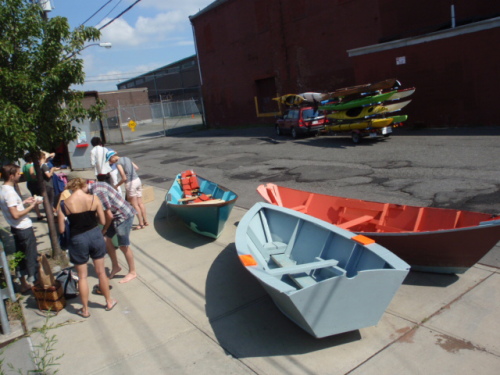
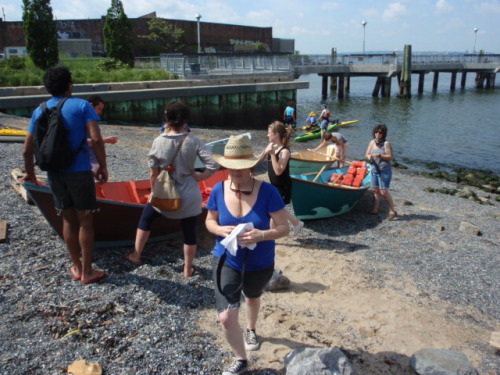
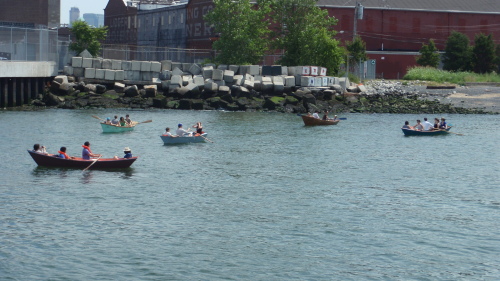
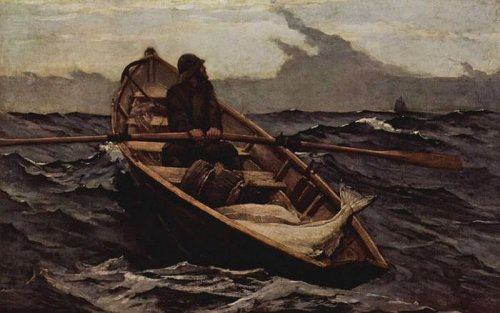
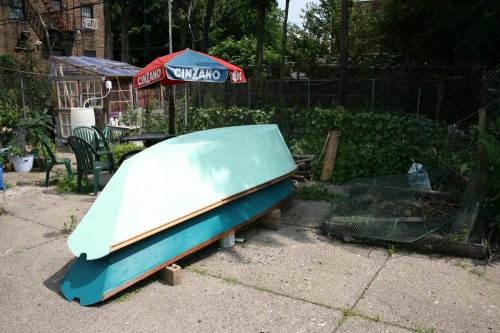
bonnie
Everyone got home safe & some lessons learned, good stuff. Still, can’t help pointing out, when you say “Enough pfd’s, plenty of line, a spare oar and a civilian band radio are not at all bad things to have along” –
A properly fitting PFD for every person on the boat isn’t just “not at all a bad idea”, it’s one of the minimum legal requirements for any boat that’s operating anywhere on our nation’s navigable waterways (and that includes the Gowanus).
If you knew that, great, sorry to be a buttinsky.
If not, you can read more about the regs on the Coast Guard’s Safe Boating site – http://www.uscgboating.org/SAFETY/fedreqs/equipment.htm . Or you could just contact the local Coast Guard Auxiliary & ask if they could send a couple of people to do a vessel safety check for you – they are usually happy to help out & it’s not at all a bad idea to have them look things over for you.
Pingback: ELIZABETH WEINBERG PHOTOGRAPHY: BLOG - boats.
robert Painter
Fellow boaters, It appears that you will be launching from VP again this year for CoW, please contact us at info@redhookboaters.org and we can discuss, thanks RED HOOK BOATERS